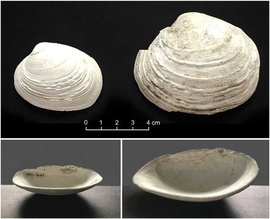Eleven-and-a-half thousand of years of Clam use on the coasts of British Columbia.
[sciencythoughts.blogspot.com]
Over the millennia, many peoples worldwide developed intimate knowledge of, and relationships with, particularly valued species of plants and animals. Tracking the development of these long-term human–species relationships requires temporally grounded records that provide insights into both the cultural and ecological sides of this equation. For instance, the archaeological faunal record can provide detailed information on the ecological and cultural effects of human–species interactions, whereas the palaeoecological record can provide insights into species ecology in the absence of significant human intervention. Taken together, these two records can offer a powerful lens through which to assess coupled social–ecological systems over broad spatial and temporal scales and can help establish ecological baselines for modern management. On the Northwest Coast of North America, clams are a valued cultural species with widespread importance that is reflected in origin stories, rituals language, and in the kilometers of deep and ancient shell middens that line the coastline. Detailed archaeological and ethnographic research indicates that Clams, especially Butter Clams, Saxidomus gigantea, and Littleneck Clam, Leukoma staminea, were eaten in abundance both seasonally and year round and both fresh and preserved. These species were a reliable, abundant, and easily harvested source of food that could be tended to increase abundance by applying various traditional cultivation techniques. One such technique, the building of rock-walled intertidal terraces called 'Clam gardens', expanded and enhanced Clam habitat and thus, Clam production.

Enjoy being online again!
Welcome to the community of good people who base their values on evidence and appreciate civil discourse - the social network you will enjoy.Create your free account
3 comments
Feel free to reply to any comment by clicking the "Reply" button.Not surprising given that following the coastline is a natural and logical decision. If the Bering Strait connection is true (evidence would support this conclusion) then a shell ridden in Btitish Columbia is only logical. The internal ice free corridor through the center of Alaka was one route, the coast was another. If migration began between 30,000 and 20,000 years ago, an 11,000 year old maiden makes sense.
We have a group here called Kwiaht [kwiaht.org] One of the things they do is go around the different islands and measure the depths of clam middens. This gives an indication of how long the aboriginal groups have been settled on the specific island. I have been on some of these measurements and was relly surrised at how deep they go.
There really isn't a season on the coast of BC that would require preservation, at least not one that I can think of after living on Vancouver Island for 5 years.
But shells of clams are made of durable calcium carbonate. The major thing that destroys them is wave action grinding them up. Preservation is not a problem. Just look at the 1000 foot cliffs of limestone around the world. They are nothing but preserved and cemented pieces of shells.
@t1nick I believe they were talking about the preservation of the clam meat as a food source, not the shells. As a custom home builder on Vancouver Island I was always apprehensive if we ran into midden while excavating a foundation, usually these indicated the native people's garbage dump and if you hit an artifact then you were going to be delayed while the Royal Archeological Society sifted through the ancient garbage dump.
Recent Visitors 26
Photos 292 More
Posted by JoeBKite-like structures in the western Sahara Desert.
Posted by TriphidAn Aussie Indigenous Message Stick.
Posted by TriphidIndigenous Australian Aboriginal Rock art dated somewhere between 20 and 30 thousand years old.
Posted by TriphidIndigenous Australian Aboriginal Rock art dated somewhere between 20 and 30 thousand years old.
Posted by TriphidIndigenous Australian Aboriginal Rock art dated somewhere between 20 and 30 thousand years old.
Posted by TriphidIndigenous Australian Aboriginal Rock art dated somewhere between 20 and 30 thousand years old.
Posted by JoeBDortoka vremiri: A new species of Dortokid Turtle from the Late Cretaceous of the Hațeg Basin, Romania.
Posted by JoeBThe Cabeço da Amoreira burial: An Early Modern Era West African buried in a Mesolithic shell midden in Portugal.
Posted by JoeBMusivavis amabilis: A new species of Enantiornithine Bird from the Early Cretaceous Jehol Biota of northeastern China.
Posted by JoeBTorosaurus in Canada.
Posted by JoeBStone tools from the Borselan Rock Shelter, in the Binalud Mountains of northeastern Iran.
Posted by JoeBDating the Lantian Biota.
Posted by JoeBBashanosaurus primitivus: A new species of Stegosaur from the Middle Jurassic of Chongqing Municipality, China.
Posted by JoeBDetermining the time of year when the Chicxulub Impactor fell.
Posted by JoeBSão Tomé and Príncipe: Possibly the last country on Earth never to have been visited by a working archaeologist.
Posted by JoeBMambawakale ruhuhu: A new species of Pseudosuchian Archosaur from the Middle Triassic Manda Beds of Tanzania.







